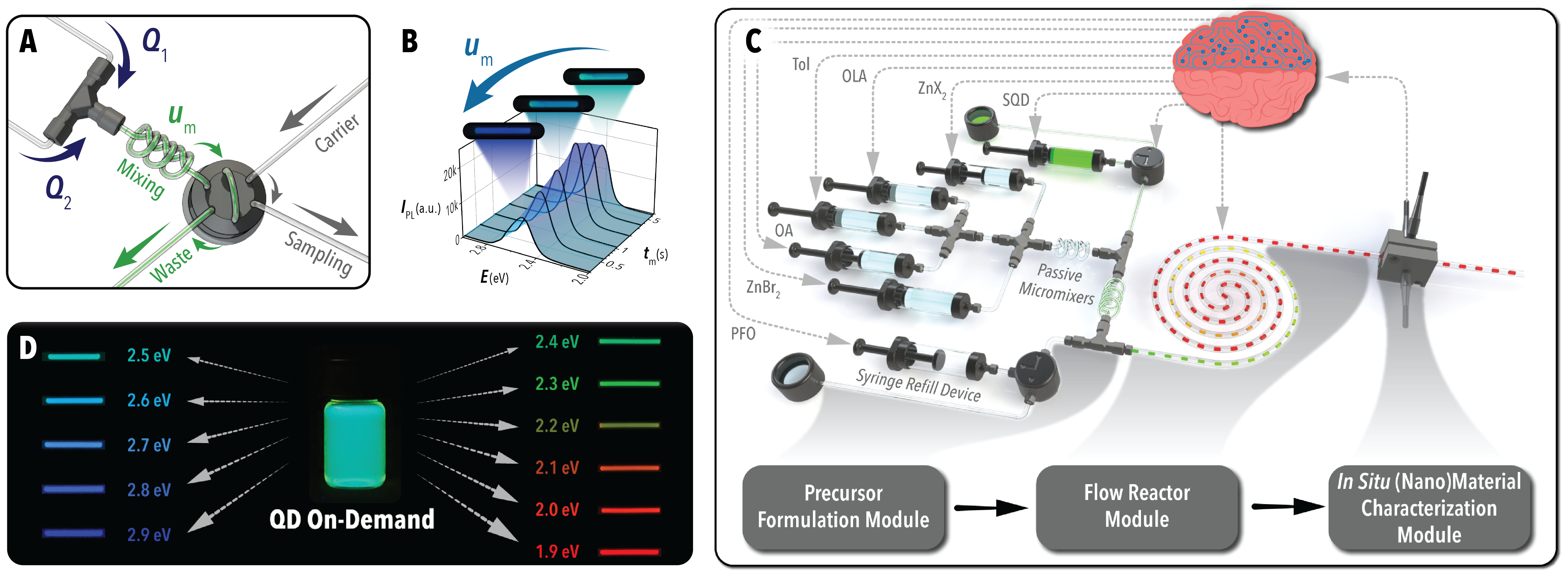(3da) Self-Optimizing Synthesis of Perovskite Quantum Dots through Modular Microfluidic Systems, Automated Data Analytics, and Machine Learning
AIChE Annual Meeting
2020
2020 Virtual AIChE Annual Meeting
Meet the Candidates Poster Sessions
Meet the Faculty and Post-Doc Candidates Poster Session
Monday, November 16, 2020 - 8:00am to 9:00am
Advection controlled growth of PQDs was studied through UV-Vis absorption and photoluminescence spectra collected through two separate platforms. The first design features a transient sampling module which enables collection of optical spectra along the full length of the reactor segment, unlocking nanocrystal growth kinetics at varying advection rates (i.e. fluid velocities) as well as a sampling rate of over 1,000 spectra per hour.[1] Flow within this system was able to be accurately monitored through a custom-built biphasic flow velocity and length meter.[2] The second design applied a novel passive micromixer to a sample loop valve – shown in Fig. A.[3] Flow velocities were altered on the micromixer side of the valve, then a sample of the reactive solution was isolated and redirected to the growth/sampling line where it was carried by a perfluorinated oil and allowed to grow for 1 min before optical sampling. This device further demonstrated that the exact same precursors, when combined at differing mixing rates, produced broadly tunable emission spectra – shown in Fig. B. The autonomous synthesis system, shown in Fig. C, used a case-study PQD halide exchange reaction, detailed in prior work,[4] to demonstrate the efficacy of ML-guided reaction systems. Using ensemble neural network modeling with decision making policies, an automated fluidic platform, and a novel reduced pathlength optical flow cell – which is the first device in tubular microfluidics capable of extracting accurate quantum yield from high concentration samples – the quantum yield and nanocrystal polydispersity were optimized simultaneously for any given emission energy. After over 1,400 conducted experiments were used to determine the most effect experiment selection algorithms, the system was able to produce optimized quantum dot formulations at 11 different emissions (Fig. D) within 30 hours and without user guidance or prior information.[5]
These automated and autonomous experimentation techniques offer substantially enhanced material exploration and alleviate researchers from the tedious components of synthesis protocol optimization. In addition to the new information they provide access to, the high sampling rates allow for exploration of larger and more complex reaction spaces. Further application of these systems and the techniques developed therein would expedite and improve the development and discovery of next-generation nanomaterials.
References
[1] R. W. Epps, K. C. Felton, C. W. Coley, M. Abolhasani, Lab Chip 2017, 17, 4040.
[2] C. B. Kerr,* R. W. Epps,* M. Abolhasani, Lab Chip 2019, 19, 2107.
[3] R. W. Epps, A. A. Volk, K. Abdel-Latif, M. Abolhasani, React. Chem. Eng. 2020, 5, 1212.
[4] K. Abdelâ€Latif,* R. W. Epps,* C. B. Kerr, C. M. Papa, F. N. Castellano, M. Abolhasani, Adv. Funct. Mater. 2019, 29, 1900712.
[5] R. W. Epps, M. S. Bowen, A. A. Volk, K. Abdelâ€Latif, S. Han, K. G. Reyes, A. Amassian, M. Abolhasani, Adv. Mater. 2020, 2001626.
Research Interests
Microfluidics, Data analytics, Machine learning, System automation, Colloidal nanomaterials
